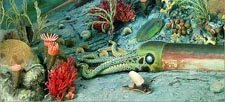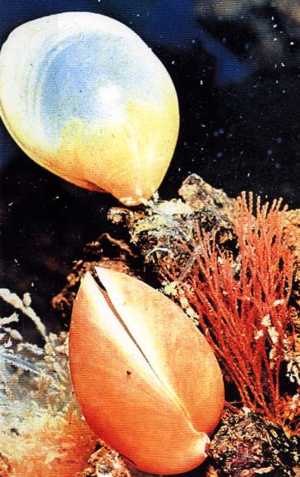 |
 |
 |
 |
 |
Produced
by the Population Genetics and Evolution class, Furman University |
||||
 |
 |
 |
 |
 |
Produced
by the Population Genetics and Evolution class, Furman University |
||||
 |
The
Ordovician: Brachiopods |
 |
||
| Brachiopods
(also known as lamp shells) were the first bilaterian animals to lose
their adult mobility and encase themselves in an external shell. They
became sessile, benthic suspension-feeders, and they are among the most
abundant fossils in the geologic record (Kazlev 2002). The shell is made
up of two parts (bivalved) and composed of calcium carbonate or calcium
phosphate and chitinous organic substance. Although similar in appearance
to clams, they belong to the group Lophophorata, related to Bryozoa and
Phoronida. They use a fringe of tentacles, known as the lophophore, for
feeding and respiration. Unlike mollusks their shell is unequal, with
one side possessing the attachment for the pedicle, a muscular stalk,
which attaches the organism to the substrate. In the past, brachiopods
have been split into two groups, Articulata (with an articulating hinge)
and Inarticulata (without), however it is now believed that these are
unreliable classifications. It has been suggested that brachiopods may
be polyphyletic, evolving from separate phoronid-like ancestors. Brachiopods
still exist today, although in much less abundance, with only 300 to 500
species surviving from the 15,000 known species. Page by Megan Aprill |
 |
| Living brachipods. Photo from: www.palaeos.com | |
| Waggoner B. 1995. Introduction to the Brachiopoda. University of California Museum of Paleontology (UCMP). Accessed Feb 6 2010. Kazlev MA. 2002. Metazoa: Lophotrochozoa: Brachipoda. www.palaeos.com. Accessed Feb 6, 2010 Brosius L. 2008. Fossil Brachiopods. GeoKansas. Accessed Feb 6, 2010. |